Zinc(II) and Copper(II) Complexes of 4-Styrylpyridine and 1-Adamantanecarboxylic Acid: Syntheses, Crystal Structures, and Photopolymerization
Abstract
1. Introduction
2. Materials and Methods
2.1. Materials and Characterizations
2.2. Preparation of [Zn3(spy)2(adc)6] (1)
2.3. Preparation of [Cu2(spy)2(adc)4][Cu(spy)2(adc)2]·2DMF (2)
2.4. Preparation of [Cu2(spy)2(adc)4][Cu(rctt-ppcb)(adc)2]·2DMF (3)
2.5. X-ray Crystallographic Analysis
3. Results and Discussion
3.1. Preparation of Zn(II) and Cu(II) Complexes (1 and 2)
3.2. Structural Description of the Zn(II) Complex (1)
3.3. Structural Description of the Cu(II) Complex (2)
3.4. Photoreactivity of Complexes 1 and 2
4. Conclusions
Supplementary Materials
Author Contributions
Funding
Institutional Review Board Statement
Informed Consent Statement
Data Availability Statement
Conflicts of Interest
References
- Wang, M.-F.; Mi, Y.; Hu, F.-L.; Hirao, H.; Niu, Z.; Braunstein, P.; Lang, J.-P. Controllable multiple-step configuration transformations in a thermal/photoinduced reaction. Nat. Commun. 2022, 13, 2847. [Google Scholar]
- Rath, B.B.; Vittal, J.J. Single-Crystal-to-Single-Crystal [2 + 2] Photocycloaddition Reaction in a Photosalient One-Dimensional Coordination Polymer of Pb(II). J. Am. Chem. Soc. 2020, 142, 20117–20123. [Google Scholar]
- Medishetty, R.; Park, I.-H.; Lee, S.S.; Vittal, J.J. Solid-state polymerisation via [2+2] cycloaddition reaction involving coordination polymers. Chem. Commun. 2016, 52, 3989–4001. [Google Scholar]
- Nakagawa, M.; Kusaka, S.; Kiyose, A.; Nakajo, T.; Iguchi, H.; Mizuno, M.; Matsuda, R. Beyond the Conventional Limitation of Photocycloaddition Reaction in the Roomy Nanospace of a Metal–Organic Framework. J. Am. Chem. Soc. 2023, 145, 12059–12065. [Google Scholar] [CrossRef] [PubMed]
- Park, I.-H.; Mulijanto, C.E.; Lee, H.-H.; Kang, Y.; Lee, E.; Chanthapally, A.; Lee, S.S.; Vittal, J.J. Influence of Interpenetration in Diamondoid Metal–Organic Frameworks on the Photoreactivity and Sensing Properties. Cryst. Growth Des. 2016, 16, 2504–2508. [Google Scholar] [CrossRef]
- Park, I.-H.; Lee, E.; Lee, S.S.; Vittal, J.J. Chemical Patterning in Single Crystals of Metal–Organic Frameworks by [2+2] Cycloaddition Reaction. Angew. Chem. Int. Ed. 2019, 58, 14860–14864. [Google Scholar] [CrossRef] [PubMed]
- Schmidt, G.M.J. Photodimerization in the solid state. Pure Appl. Chem. 1971, 27, 647–678. [Google Scholar]
- Cohen, M.D.; Schmidt, G.M.J.; Sonntag, F.I. 384. Topochemistry. Part II. The photochemistry of trans-cinnamic acids. J. Chem. Soc. Resumed 1964, 2000–2013. [Google Scholar]
- Chakraborty, G.; Park, I.-H.; Medishetty, R.; Vittal, J.J. Two-Dimensional Metal-Organic Framework Materials: Synthesis, Structures, Properties and Applications. Chem. Rev. 2021, 121, 3751–3891. [Google Scholar]
- Vittal, J.J.; Quah, H.S. Photochemical reactions of metal complexes in the solid state. Dalton Trans. 2017, 46, 7120–7140. [Google Scholar]
- Georgiev, I.G.; MacGillivray, L.R. Metal-mediated reactivity in the organic solid state: From self-assembled complexes to metal–organic frameworks. Chem. Soc. Rev. 2007, 36, 1239–1248. [Google Scholar]
- Vittal, J.J.; Quah, H.S. Engineering solid state structural transformations of metal complexes. Coord. Chem. Rev. 2017, 342, 1–18. [Google Scholar]
- Sherman, D.A.; Murase, R.; Duyker, S.G.; Gu, Q.; Lewis, W.; Lu, T.; Liu, Y.; D’Alessandro, D.M. Reversible single crystal-to-single crystal double [2+2] cycloaddition induces multifunctional photo-mechano-electrochemical properties in framework materials. Nat. Commun. 2020, 11, 2808. [Google Scholar]
- Medishetty, R.; Yap, T.T.S.; Koh, L.L.; Vittal, J.J. Thermally reversible single-crystal to single-crystal transformation of mononuclear to dinuclear Zn(ii) complexes by [2+2] cycloaddition reaction. Chem. Commun. 2013, 49, 9567–9569. [Google Scholar]
- Morris, R.E.; Brammer, L. Coordination change, lability and hemilability in metal–organic frameworks. Chem. Soc. Rev. 2017, 46, 5444–5462. [Google Scholar]
- Medishetty, R.; Tandiana, R.; Vittal, J.J. Stepwise Host–Guest [2 + 2] Photoreaction in a Hydrogen-Bonded One-Dimensional Coordination Polymer to a Two-Dimensional Layered Structure. Cryst. Growth Des. 2014, 14, 3186–3190. [Google Scholar]
- Medishetty, R.; Koh, L.L.; Kole, G.K.; Vittal, J.J. Solid-State Structural Transformations from 2D Interdigitated Layers to 3D Interpenetrated Structures. Angew. Chem. Int. Ed. 2011, 50, 10949–10952. [Google Scholar]
- Medishetty, R.; Tandiana, R.; Koh, L.L.; Vittal, J.J. Assembly of 3D Coordination Polymers from 2D Sheets by [2+2] Cycloaddition Reaction. Chem. Eur. J. 2014, 20, 1231–1236. [Google Scholar]
- Park, I.-H.; Ju, H.; Kim, K.; Lee, S.S.; Vittal, J.J. Isomerism in double-pillared-layer coordination polymers - structures and photoreactivity. IUCrJ 2018, 5, 182–189. [Google Scholar] [CrossRef]
- Park, I.-H.; Sasaki, K.; Quah, H.S.; Lee, E.; Ohba, M.; Lee, S.S.; Vittal, J.J. Metal Organo-Polymeric Framework via [2 + 2] Cycloaddition Reaction: Influence of Hydrogen Bonding on Depolymerization. Cryst. Growth Des. 2019, 19, 1996–2000. [Google Scholar]
- Ju, H.; Shin, M.; Park, I.-H.; Jung, J.H.; Vittal, J.J.; Lee, S.S. Construction of 2D Interdigitated Polyrotaxane Layers and their Transformation to a 3D Polyrotaxane by a Photocycloaddition Reaction between Wheels. Inorg. Chem. 2021, 60, 8285–8292. [Google Scholar]
- Yadava, K.; Gallo, G.; Bette, S.; Mulijanto, C.E.; Karothu, D.P.; Park, I.-H.; Medishetty, R.; Naumov, P.; Dinnebier, R.E.; Vittal, J.J. Extraordinary anisotropic thermal expansion in photosalient crystals. IUCrJ 2020, 7, 83–89. [Google Scholar] [CrossRef]
- Rath, B.B.; Vittal, J.J. Mechanical Bending and Modulation of Photoactuation Properties in a One-Dimensional Pb(II) Coordination Polymer. Chem. Mater. 2021, 33, 4621–4627. [Google Scholar]
- Mulijanto, C.E.; Quah, H.S.; Tan, G.K.; Donnadieu, B.; Vittal, J.J. Curved crystal morphology, photoreactivity and photosalient behaviour of mononuclear Zn(II) complexes. IUCrJ 2017, 4, 65–71. [Google Scholar] [CrossRef] [PubMed]
- Medishetty, R.; Sahoo, S.C.; Mulijanto, C.E.; Naumov, P.; Vittal, J.J. Photosalient Behavior of Photoreactive Crystals. Chem. Mater. 2015, 27, 1821–1829. [Google Scholar]
- Yadava, K.; Vittal, J.J. Photosalient Behavior of Photoreactive Zn(II) Complexes. Cryst. Growth Des. 2019, 19, 2542–2547. [Google Scholar] [CrossRef]
- Chanthapally, A.; Kole, G.K.; Qian, K.; Tan, G.K.; Gao, S.; Vittal, J.J. Thermal Cleavage of Cyclobutane Rings in Photodimerized Coordination-Polymeric Sheets. Chem. Eur. J. 2012, 18, 7869–7877. [Google Scholar] [CrossRef]
- Kole, G.K.; Tan, G.K.; Vittal, J.J. Solid state photodimerization of trans-2-(4-pyridyl)-4-vinylbenzoic acid via salt formation and isomerisation of cyclobutane compounds in solution. CrystEngComm 2012, 14, 7438–7443. [Google Scholar] [CrossRef]
- Brockmann, H.; Schmidt-Kastner, G. Valinomycin I, XXVII. Mitteil. über Antibiotica aus Actinomyceten. Chem. Ber. 1955, 88, 57–61. [Google Scholar] [CrossRef]
- Horwitz, L. Notes - Studies in cis- and trans-Stilbazoles. J. Org. Chem. 1956, 21, 1039–1041. [Google Scholar] [CrossRef]
- Williams, J.L.R.; Adel, R.E.; Carlson, J.M.; Reynolds, G.A.; Borden, D.G.; Ford, J.A., Jr. A Comparison of Methods for the Preparation of 2- and 4-Styrylpyridines1. J. Org. Chem. 1963, 28, 387–390. [Google Scholar] [CrossRef]
- Efange, S.M.N.; Michelson, R.H.; Remmel, R.P.; Boudreau, R.J.; Dutta, A.K.; Freshler, A. Flexible N-methyl-4-phenyl-1,2,3,6-tetrahydropyridine analog: Synthesis and monoamine oxidase catalyzed bioactivation. J. Med. Chem. 1990, 33, 3133–313833. [Google Scholar] [PubMed]
- Bruker, A.J.B.A.I. Saint and SADABS; Bruker AXS Inc.: Madison, WI, USA, 2009. [Google Scholar]
- Sheldrick, G. Shelxtl, N.J.U.o.G.; Program for the Solution and Refinement of Crystal Structures: Göttingen, Germany, 1997. [Google Scholar]
- Wang, J.-J.; Chang, Z.; Zhang, A.-S.; Hu, T.-L.; Bu, X.-H. Copper(II) complexes with monocarboxylate ligands bearing different substituent groups: Synthesis and spectroscopic studies. Inorg. Chim. Acta 2010, 363, 1377–1385. [Google Scholar]
- Spek, A. Single-crystal structure validation with the program PLATON. J. Appl. Crystallogr. 2003, 36, 7–13. [Google Scholar] [CrossRef]
- Gupta, P.; Karothu, D.P.; Ahmed, E.; Naumov, P.; Nath, N.K. Thermally Twistable, Photobendable, Elastically Deformable, and Self-Healable Soft Crystals. Angew. Chem. Int. Ed. 2018, 57, 8498–8502. [Google Scholar] [CrossRef] [PubMed]
- Oh, H.; Kim, D.; Kim, D.; Park, I.-H.; Jung, O.-S. 2D Porous Organic Templates via Cocrystallization of Melamine with Disulfonic Acids: Adsorption of Various Alcohols in SCSC Mode. Cryst. Growth Des. 2020, 20, 7027–7033. [Google Scholar]
- Morimoto, M.; Irie, M. A Diarylethene Cocrystal that Converts Light into Mechanical Work. J. Am. Chem. Soc. 2010, 132, 14172–14178. [Google Scholar] [CrossRef]
- Kole, G.K.; Koh, L.L.; Lee, S.Y.; Lee, S.S.; Vittal, J.J. A new ligand for metal-organic framework and co-crystal synthesis: Mechanochemical route to rctt-1,2,3,4-tetrakis-(4[prime or minute]-carboxyphenyl)-cyclobutane. Chem. Commun. 2010, 46, 3660–3662. [Google Scholar]
- Ghorai, S.; Sumrak, J.C.; Hutchins, K.M.; Bučar, D.-K.; Tivanski, A.V.; MacGillivray, L.R. From co-crystals to functional thin films: Photolithography using [2+2] photodimerization. Chem. Sci. 2013, 4, 4304–4308. [Google Scholar]
- Bolla, G.; Sarma, B.; Nangia, A.K. Crystal Engineering of Pharmaceutical Cocrystals in the Discovery and Development of Improved Drugs. Chem. Rev. 2022, 122, 11514–11603. [Google Scholar]
- Acebedo-Martínez, F.J.; Domínguez-Martín, A.; Alarcón-Payer, C.; Frontera, A.; Ibáñez, Á.; Choquesillo-Lazarte, D. Evaluation of synthon influence on ethenzamide–polyphenol pharmaceutical cocrystals. CrystEngComm 2023, 25, 3150–3163. [Google Scholar] [CrossRef]
- Tiekink, E.R.T.; Vittal, J.J. Frontiers in Crystal Engineering; John Wiley & Sons: Chichester, UK, 2006. [Google Scholar]

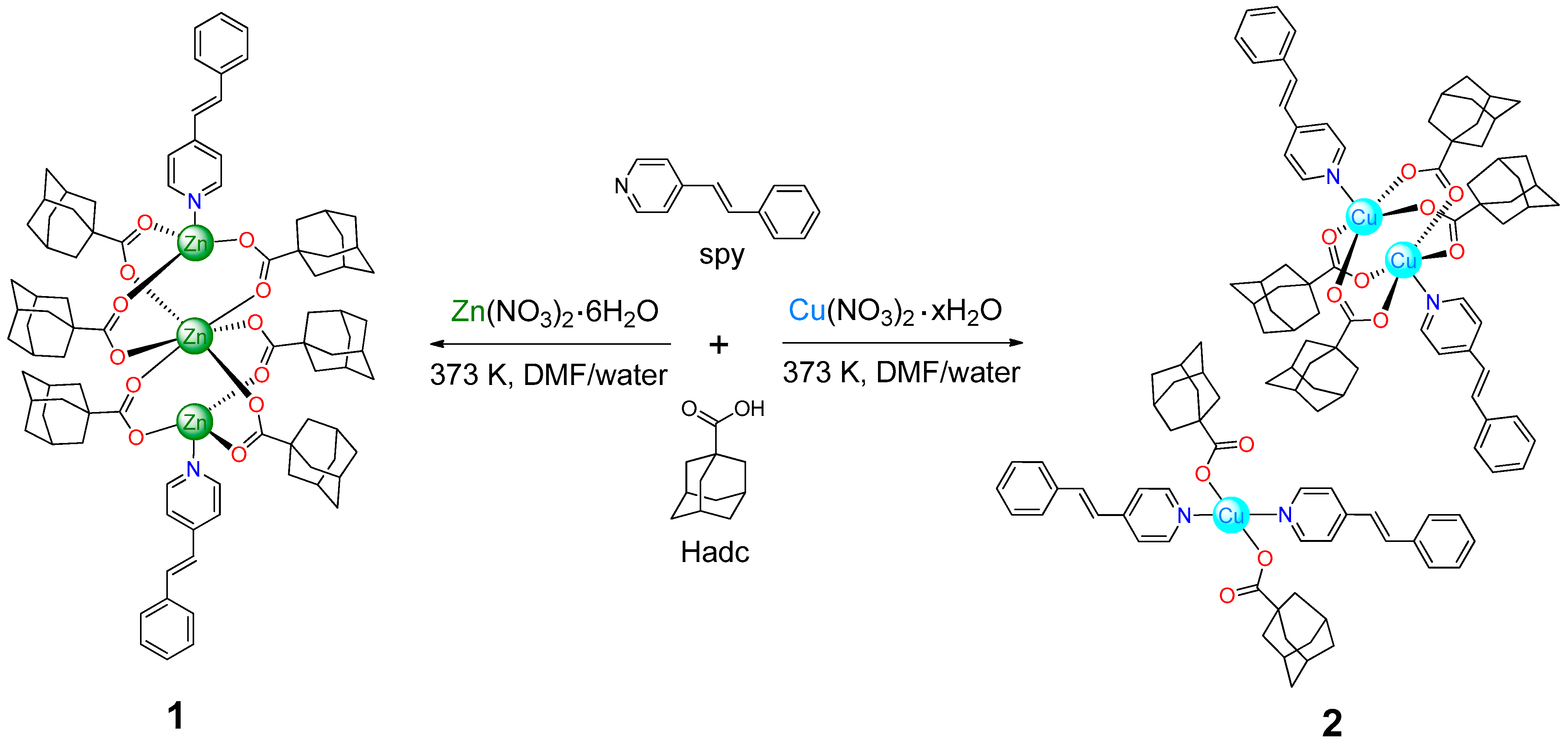
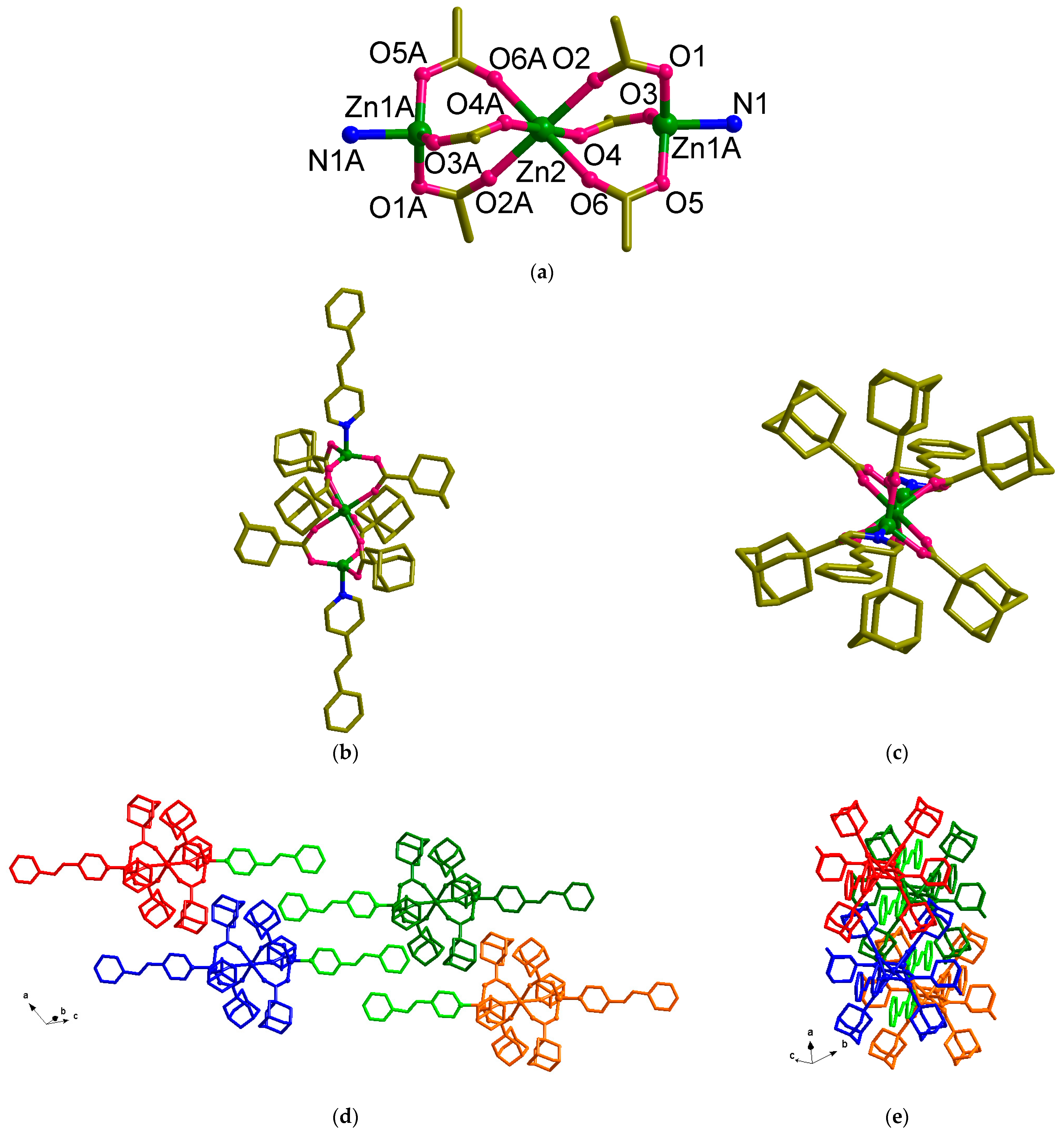
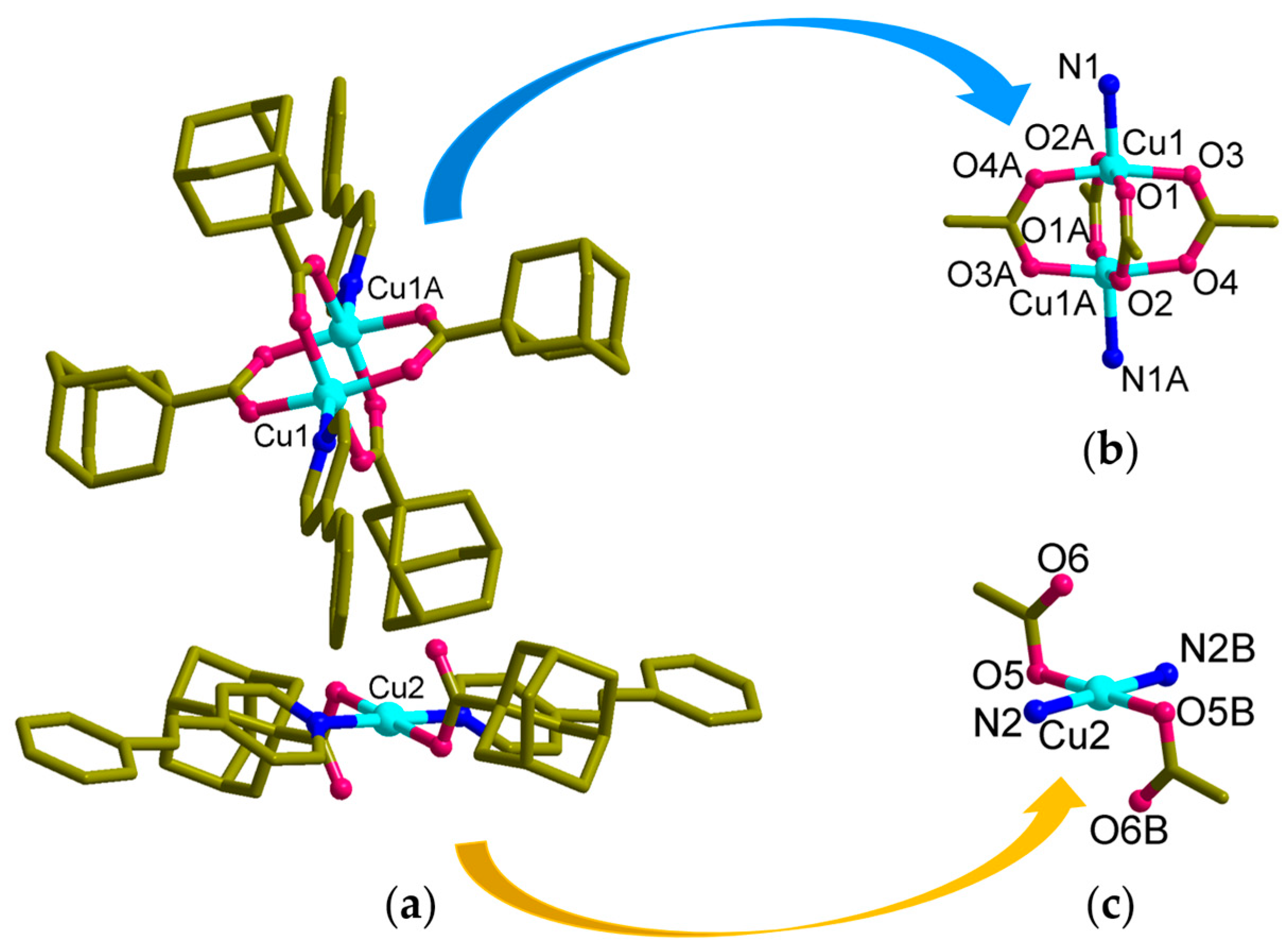
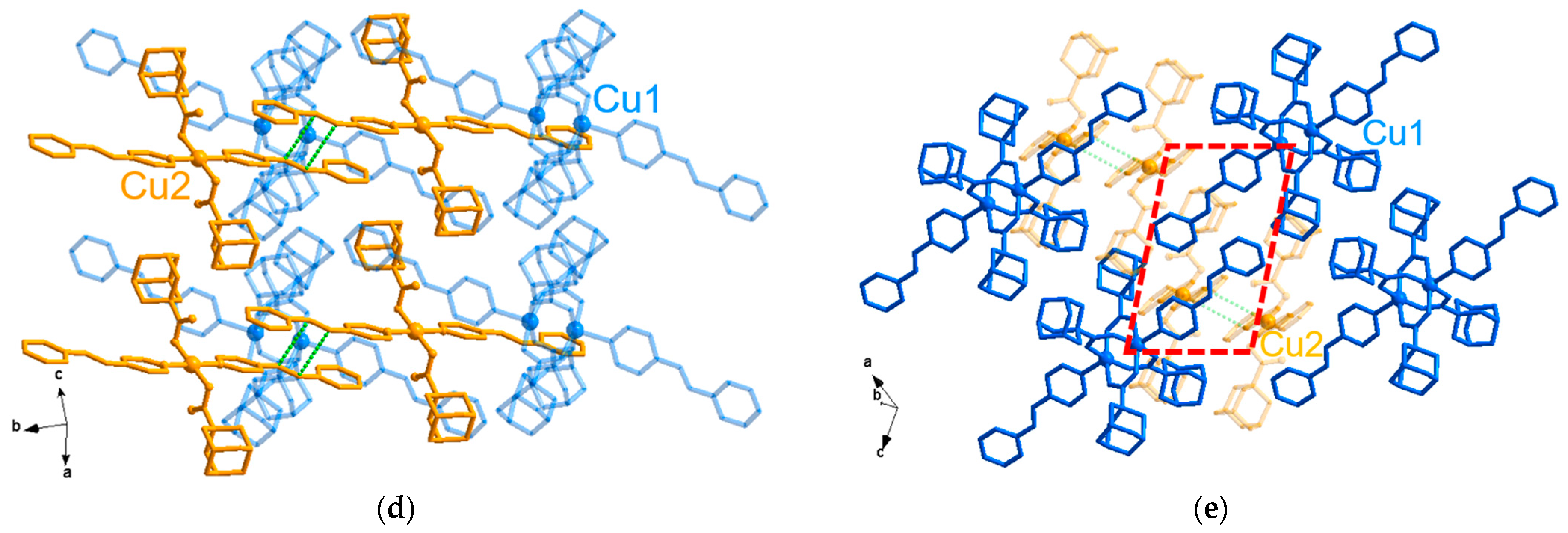
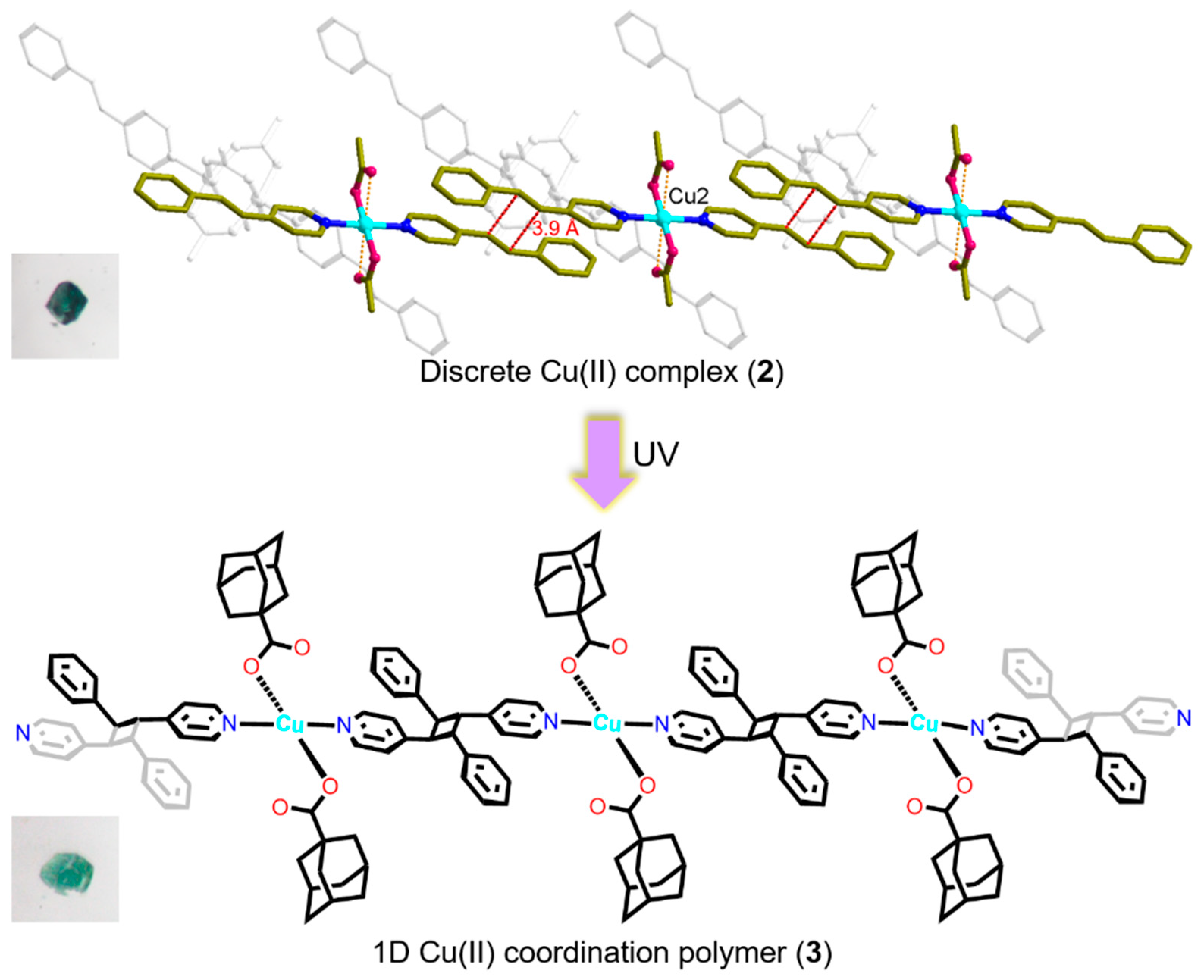
| 1 | 2 | |
| Formula | C92H112N2O12Zn3 | C124H148Cu3N6O14 |
| Formula weight | 1633.94 | 2137.10 |
| Temperature (K) | 173(2) | 173(2) |
| Crystal system | Triclinic | Triclinic |
| Space group | P-1 | P-1 |
| Z | 1 | 1 |
| a (Å) | 12.2791(3) | 13.2103(11) |
| b (Å) | 12.5594(3) | 13.8734(12) |
| c (Å) | 14.2650(3) | 16.6325(13) |
| α (°) | 92.7740(10) | 102.709(4) |
| β (°) | 115.2400(10) | 111.677(4) |
| γ (°) | 92.8270(10) | 92.990(5) |
| V (Å3) | 1981.59(8) | 2733.2(4) |
| Dcalc (g/cm3) | 1.369 | 1.298 |
| 2θmax (°) | 52.00 | 52.00 |
| R1, wR2 [I > 2σ(I)] | 0.0912, 0.2742 | 0.0616, 0.1499 |
| R1, wR2 [all data] | 0.0988, 0.2819 | 0.1069, 0.1716 |
| Goodness-of-fit on F2 | 1.077 | 1.060 |
| No. of reflection used [>2σ(I)] | 7777 [Rint = 0.0347] | 10,697 [Rint = 0.0850] |
| Refinement | 34,226 | 47,635 |
Disclaimer/Publisher’s Note: The statements, opinions and data contained in all publications are solely those of the individual author(s) and contributor(s) and not of MDPI and/or the editor(s). MDPI and/or the editor(s) disclaim responsibility for any injury to people or property resulting from any ideas, methods, instructions or products referred to in the content. |
© 2023 by the authors. Licensee MDPI, Basel, Switzerland. This article is an open access article distributed under the terms and conditions of the Creative Commons Attribution (CC BY) license (https://creativecommons.org/licenses/by/4.0/).
Share and Cite
Lee, D.H.; An, J.; Oh, J.; Park, I.-H. Zinc(II) and Copper(II) Complexes of 4-Styrylpyridine and 1-Adamantanecarboxylic Acid: Syntheses, Crystal Structures, and Photopolymerization. Crystals 2023, 13, 1226. https://doi.org/10.3390/cryst13081226
Lee DH, An J, Oh J, Park I-H. Zinc(II) and Copper(II) Complexes of 4-Styrylpyridine and 1-Adamantanecarboxylic Acid: Syntheses, Crystal Structures, and Photopolymerization. Crystals. 2023; 13(8):1226. https://doi.org/10.3390/cryst13081226
Chicago/Turabian StyleLee, Dong Hee, Jaewook An, Jihye Oh, and In-Hyeok Park. 2023. "Zinc(II) and Copper(II) Complexes of 4-Styrylpyridine and 1-Adamantanecarboxylic Acid: Syntheses, Crystal Structures, and Photopolymerization" Crystals 13, no. 8: 1226. https://doi.org/10.3390/cryst13081226
APA StyleLee, D. H., An, J., Oh, J., & Park, I.-H. (2023). Zinc(II) and Copper(II) Complexes of 4-Styrylpyridine and 1-Adamantanecarboxylic Acid: Syntheses, Crystal Structures, and Photopolymerization. Crystals, 13(8), 1226. https://doi.org/10.3390/cryst13081226









